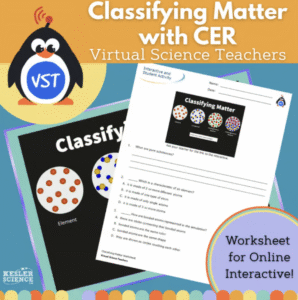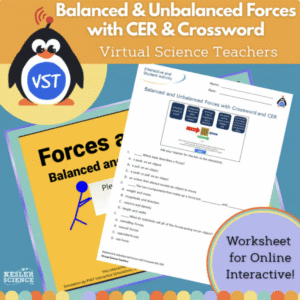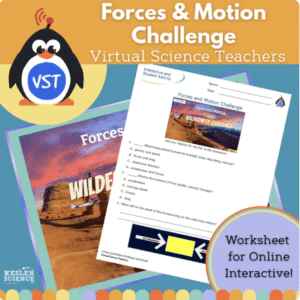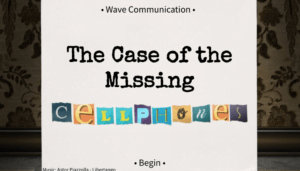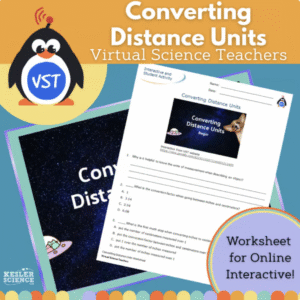How to Use This Page
- Open an accordion (e.g., Chemistry Concepts, Physics Concepts).
- Select a topic tab (e.g., Energy, Forces and Motion).
- Find your desired resource and click the Launch button to open the module.
Note: All links open in a new tab.
Chemistry Concepts
Introduction to Matter
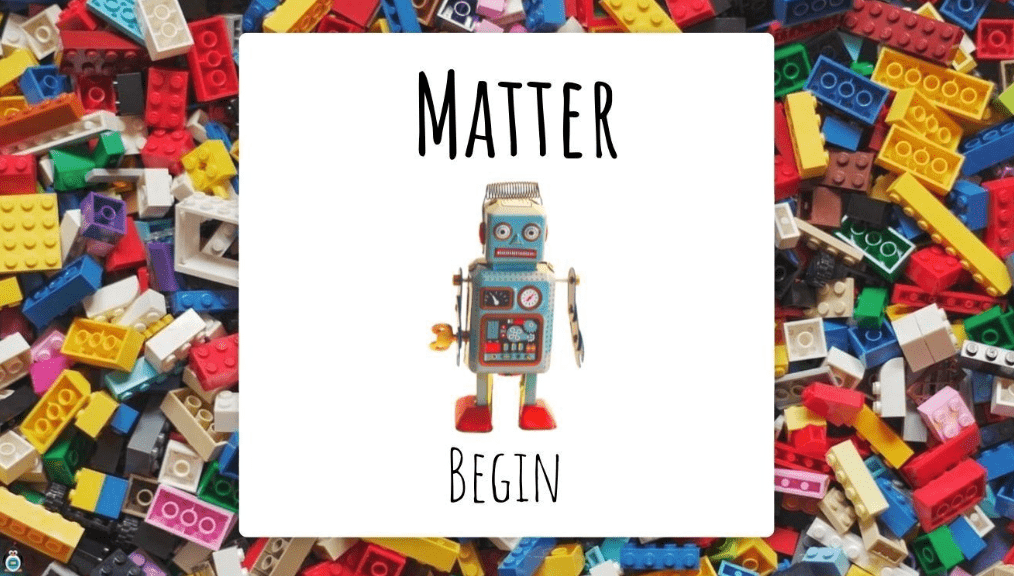
- Definition of Matter: Explains that matter has mass and takes up space.
- Mass vs. Weight: Distinguishes between mass (amount of matter) and weight (gravity’s force on mass).
- Measurement Tools: Demonstrates how to measure mass with a scale and volume with a graduated cylinder.
- Screenshot Signature Page: Users can sign and screenshot the final page for proof of completion.
- Teacher Click-Through: A version without the screenshot page for quick module review.
History of Understanding Atoms

- History of Atomic Models: Explores key contributors to atomic theory (Dalton, Thomson, Rutherford, Bohr).
- Structure of Atoms: Describes protons, neutrons, and electrons.
- NGSS MS-PS-1
- Virginia SOL PS.2 & CH.2
- Texas TEK 8.5a
- Read-Aloud Feature: Users can click buttons to hear the text read aloud.
- Signature Page: Users can sign and screenshot the final page for proof of completion.
- Teacher Click-Through: A version without the screenshot page for quick module review.
- Crossword

Introduction to Atoms
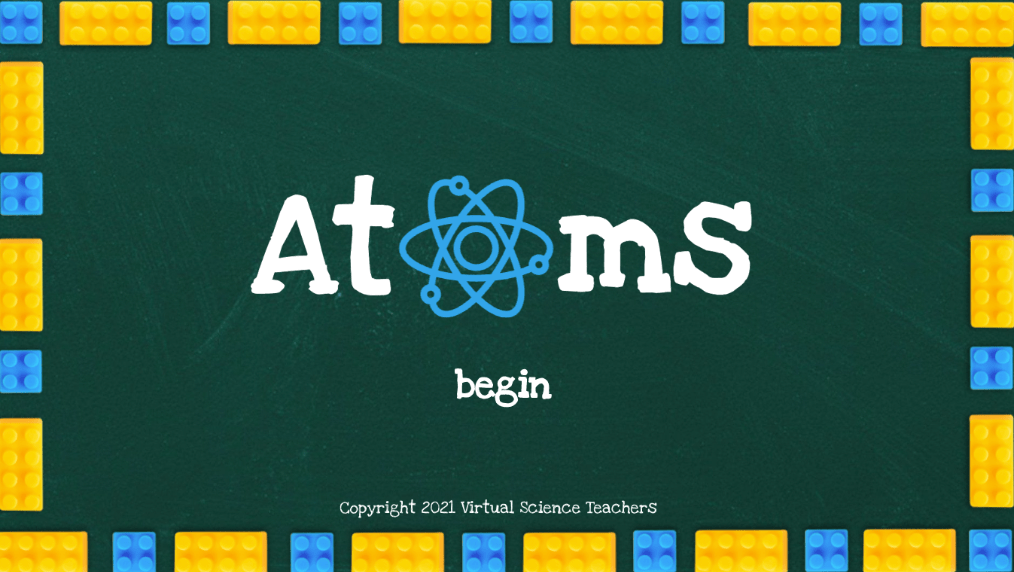
Concepts:
- What is matter?
- Atoms as building blocks
- Periodic Table basics
- Atomic structure (protons, neutrons, electrons)
- Mass number and ions
- Properties of elements
Standards:
- NGSS: PS1-1&2
- VA SOL 6.5, PS.4, CH.2
- TEK 8.6
- Read-Aloud Feature: Users can click buttons to hear the text read aloud.
- Signature Page: Users can sign and screenshot the final page for proof of completion.
- Teacher Click-Through: A version without the screenshot page for quick module review.
- Crossword
- Worksheet + Crossword
Atoms Review
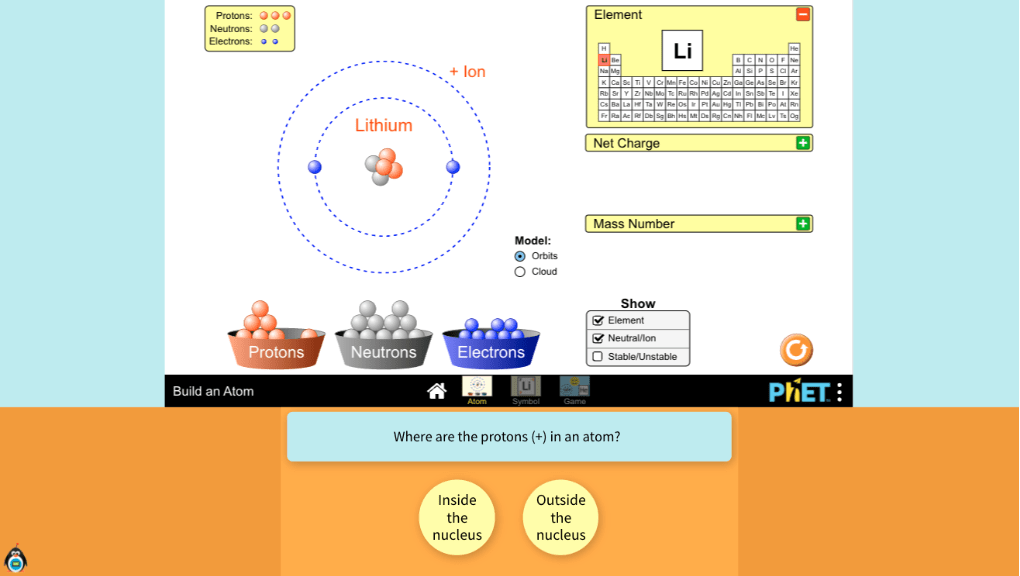
Concepts:
- Periodic Table basics
- Atomic structure (protons, neutrons, electrons)
- Mass number and ions
Standards:
- NGSS: PS1-1&2
- VA SOL 6.5, PS.4, CH.2
- Screenshot Signature Page: Users can sign and screenshot the final page for proof of completion.
Teacher Click-Through Preview: This version allows teachers to quickly click through the module. The signature page at the end has been disabled.
The Periodic Table Part 1
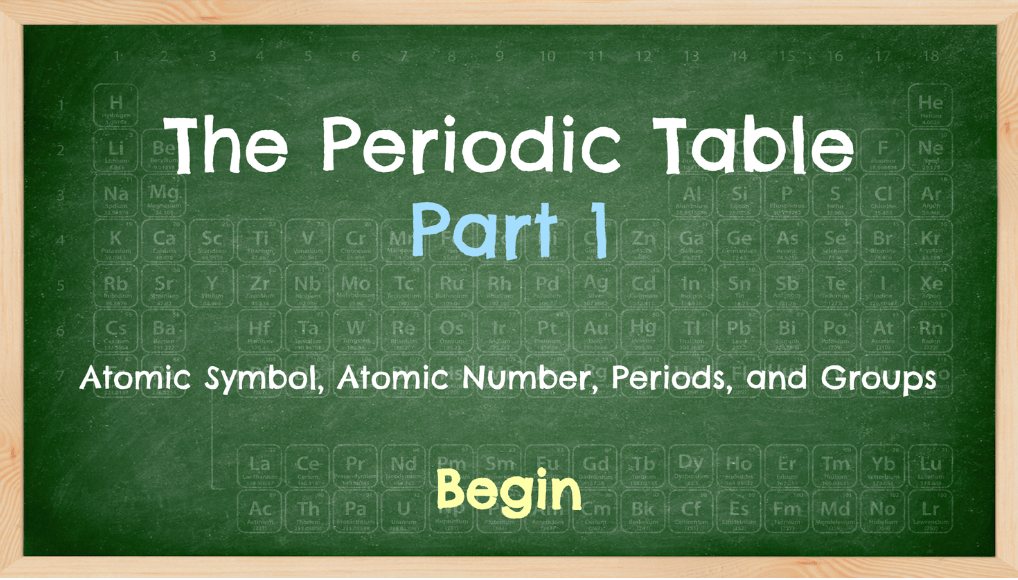
Concepts:
- Atomic symbol
- Atomic number
- Periods and Groups
Standards:
- NGSS: PS1-1&2
- VA SOL 6.5, PS.4, CH.2
- TEK 8.6
- Read-Aloud Feature: Users can click buttons to hear the text read aloud.
- Signature Page: Users can sign and screenshot the final page for proof of completion.
- Teacher Click-Through: A version without the screenshot page for quick module review.
- Periodic Table Coloring Page

- Crossword

The Periodic Table Part 2
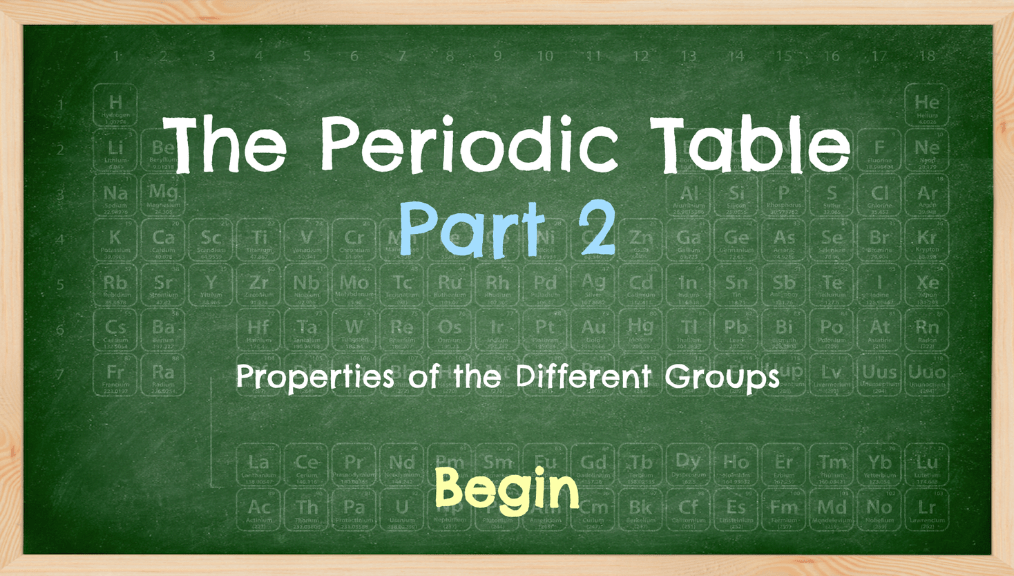
Concepts:
- Properties of the Periodic Table Groups
Standards:
- NGSS: PS1-1&2
- VA SOL 6.5, PS.4, CH.2
- TEK 8.6
- Read-Aloud Feature: Users can click buttons to hear the text read aloud.
- Signature Page: Users can sign and screenshot the final page for proof of completion.
- Teacher Click-Through: A version without the screenshot page for quick module review.
- Periodic Table Coloring Page

- Crossword

The Periodic Table Part 3
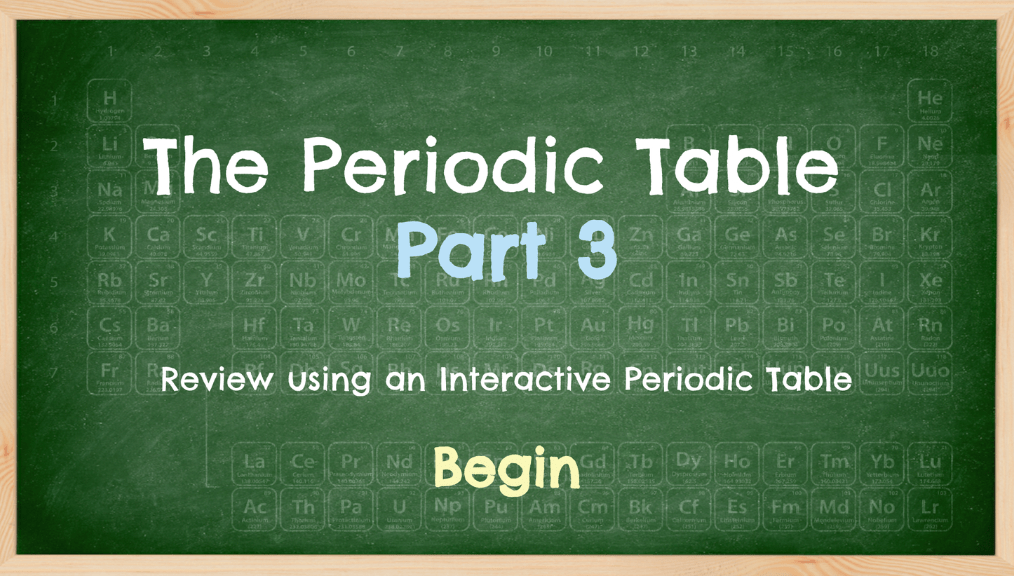
Concepts:
Review your understanding of the concepts taught in parts one and two.
- Atomic symbol
- Atomic number
- Periods and Groups
- Properties of the Periodic Table Groups
Standards:
- NGSS: PS1-1&2
- VA SOL 6.5, PS.4, CH.2
- TEK 8.6
- Signature Page: Users can sign and screenshot the final page for proof of completion.
- Teacher Click-Through: A version without the screenshot page for quick module review.
- Periodic Table Coloring Page

- Crossword

Periodic Table Escape Room
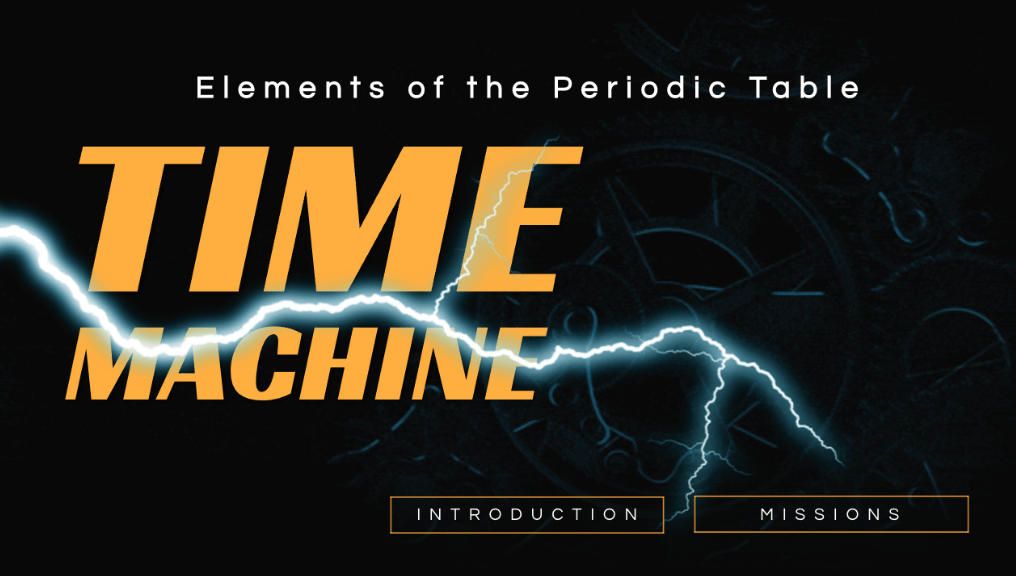
Solve periodic table challenges to uncover a code lost in time, crucial for activating life-saving technology on Mars!
- Video: One small section includes this You Tube Video from Science News. The interactive can still be completed if the video is blocked.
- Screenshot Signature Page: Users can sign and screenshot the final page for proof of completion.
- Teacher Click-Through: A version without the screenshot page for quick module review.
- Periodic Table Coloring Page

- Crossword

Periodic Table Bingo
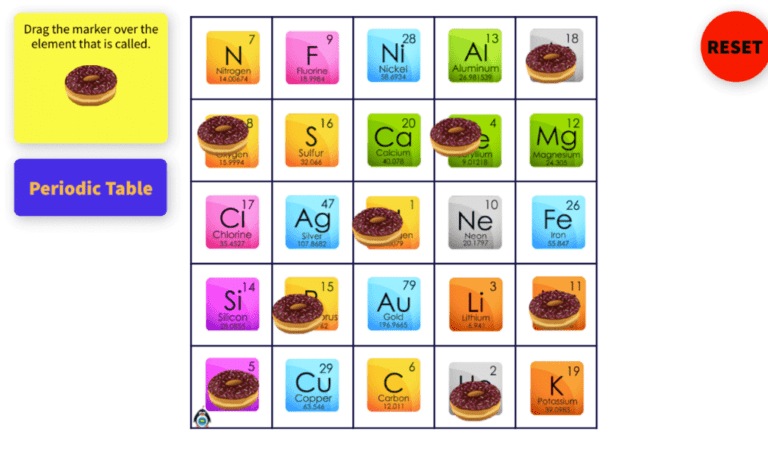
Concepts:
Each student gets their own unique bingo card as the teacher reads the provided clues from any of 12 clue sets.
- Atomic symbol
- Atomic number
- Periods and Groups
- Valence Electrons
- Ions
- Isotopes
Standards:
- NGSS: PS1-1&2
- VA SOL 6.5, PS.4, CH.2
- TEK 8.6
- Unique Bingo Cards
- 12 Clue Sets
Molecules

- This engaging interactive lesson uses molecular models and pie charts, helping students visualize and understand the composition of air.
- NGSS PS1-1, 2, 3
- Virginia SOL PS.3 & CH.3
- Read-Aloud Feature: Users can click buttons to hear the text read aloud.
- Signature Page: Users can sign and screenshot the final page for proof of completion.
- Teacher Click-Through: A version without the screenshot page for quick module review.
Classifying Matter

- This module begins by explaining the difference between elements and compounds, followed by an introduction to mixtures. It then delves deeper into the distinction between homogeneous and heterogeneous mixtures.
- NGSS PS1
- Virginia SOL PS.3b
- TEKS 8.6.A
Screenshot Page: Users enter their name on the first page, which is then displayed on the final page for a screenshot to verify credit.
- Coming soon– Teacher Click-Through: A version without the screenshot page for quick module review.
- TPT Worksheet
Chemical Formulas Part 1

Concepts:
Students check their understanding by identifying elements and determining the number of atoms in a chemical formula.
Standards:
- NGSS: PS1-5, HS-PS1-7
- VA SOL , 6.5e, PS.3D, CH.3a
- TEK 7.6.B, 8.6.B
- Read-Aloud Feature: Users can click buttons to hear the text read aloud.
- Signature Page: Users can sign and screenshot the final page for proof of completion.
Chemical Formulas Part 2

Concepts:
Students check their understanding by identifying elements and determining the number of atoms in a chemical formula.
Standards:
- NGSS: PS1-5, HS-PS1-7
- VA SOL , 6.5e, PS.3D, CH.3a
- TEK 7.6.B, 8.6.B
- Read-Aloud Feature: Users can click buttons to hear the text read aloud.
- Signature Page: Users can sign and screenshot the final page for proof of completion.
Count the Atoms Practice

Concepts:
Students practice counting atoms in chemical formulas across varying difficulty levels, reinforcing their understanding of molecular composition and atomic symbols, with a fun challenge scoring system to track their progress.
Standards:
- NGSS: PS1-5, HS-PS1-7
- VA SOL , 6.5e, PS.3D, CH.3a
- TEK 7.6.B, 8.6.B
- Scored challenge for practice
Electron Configuration
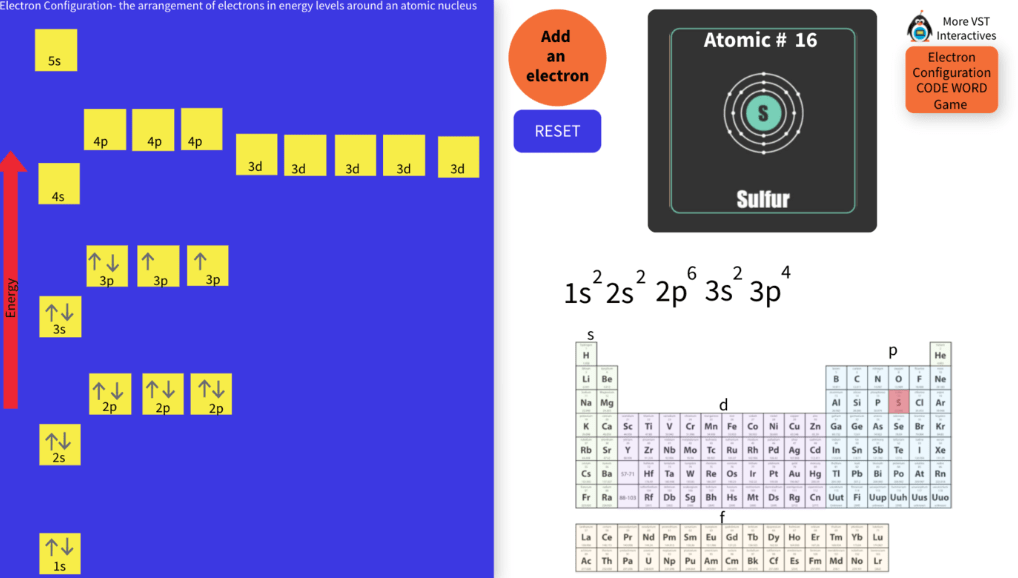
Model the electron configurations of elements hydrogen through strontium. Play a review game to check for understanding.
States of Matter

Use your understanding of solids, liquids, gases, and plasma to make in through your science teacher’s not-so haunted house.
- NGSS PS1-4
- Virginia SOL5.7,PS.2c, PS.3b
- TEKS 6.6a, 7.8c
- Read-Aloud Feature: Users can click buttons to hear the text read aloud.
- Screenshot Signature Page: Users can sign and screenshot the final page for proof of completion.
Virtual Heating Ice Lab
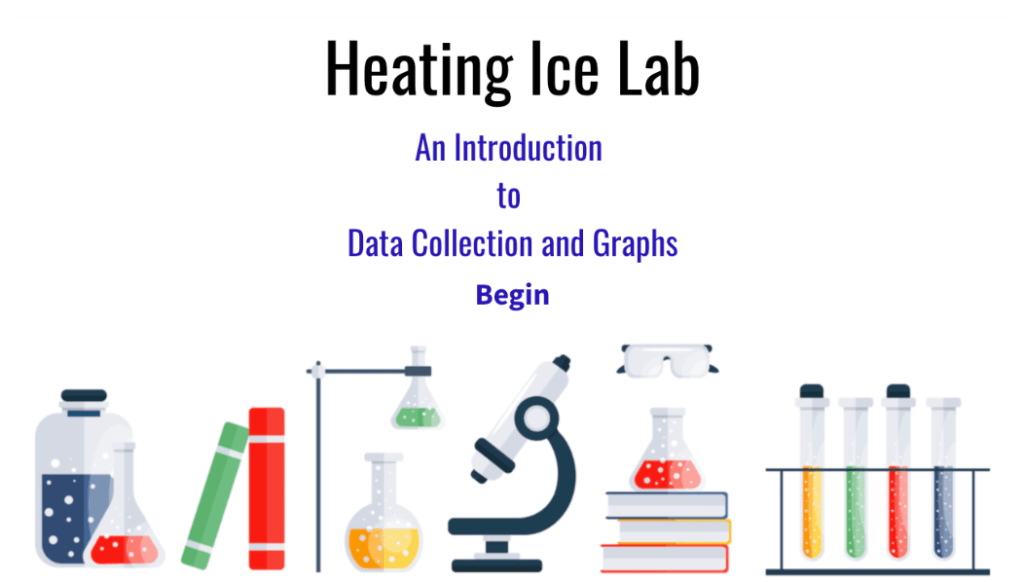
Measure, record, and graph the temperature of ice as it transitions through phase changes—melting, heating, and eventually boiling. Use the resulting temperature vs. time graph to analyze patterns and answer questions about the states of matter, energy transfer, and phase changes.
- NGSS PS1-4, 3-4
- Virginia SOL5.7, PS1, PS.2c, PS.3b
- TEKS 6.6a, 7.8c
Screenshot Signature Page: Users can screenshot their name on the final page for proof of completion.
Wild Wild Earth Part 1
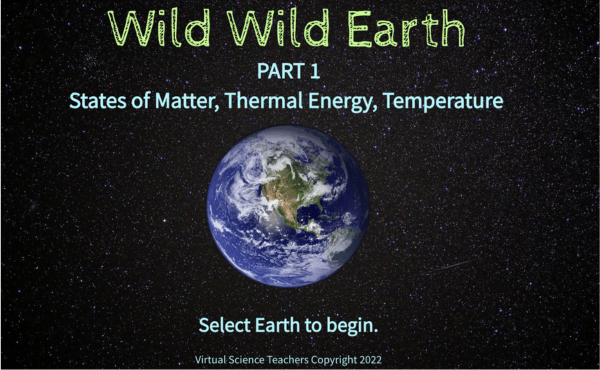
Concepts:
Travel the world as you learn about states of matter, thermal energy, and temperature.
Screenshot Signature Page: Users can screenshot their name on the final page for proof of completion.
Wild Wild Earth Part 2
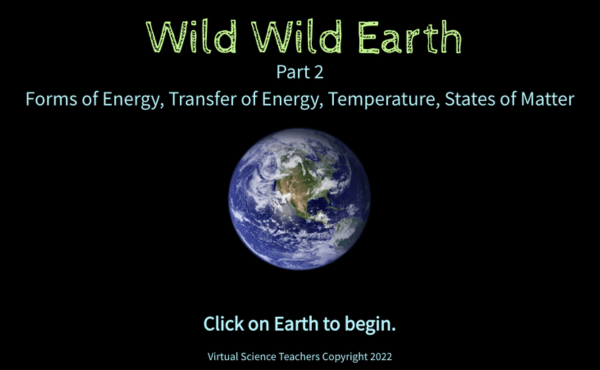
Travel the world and learn about forms of energy, temperature, and states of matter.
- Screenshot Signature Page: Users can sign and screenshot the final page for proof of completion.
Wild Wild Earth Part 3

Travel the world as you learn about heat, the states and density of water, and insulators.
Screenshot Signature Page: Users can screenshot their name on the final page for proof of completion.
Wild Wild Earth Part 4
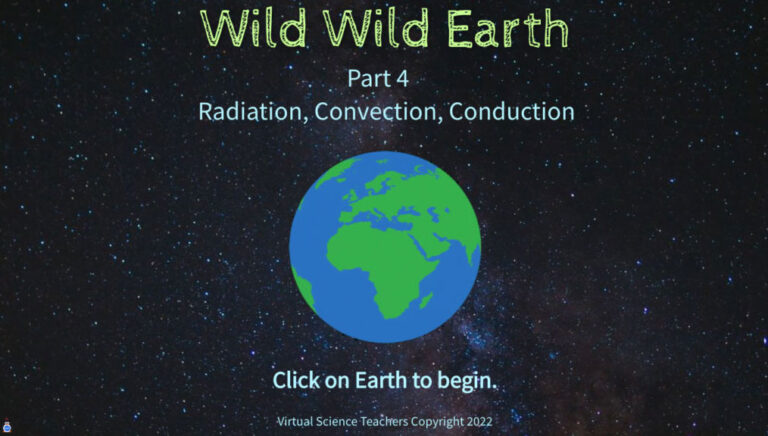
Concepts:
Travel the world as you learn about radiation, convection, and conduction.
Screenshot Signature Page: Users can screenshot their name on the final page for proof of completion.
Introduction to Density
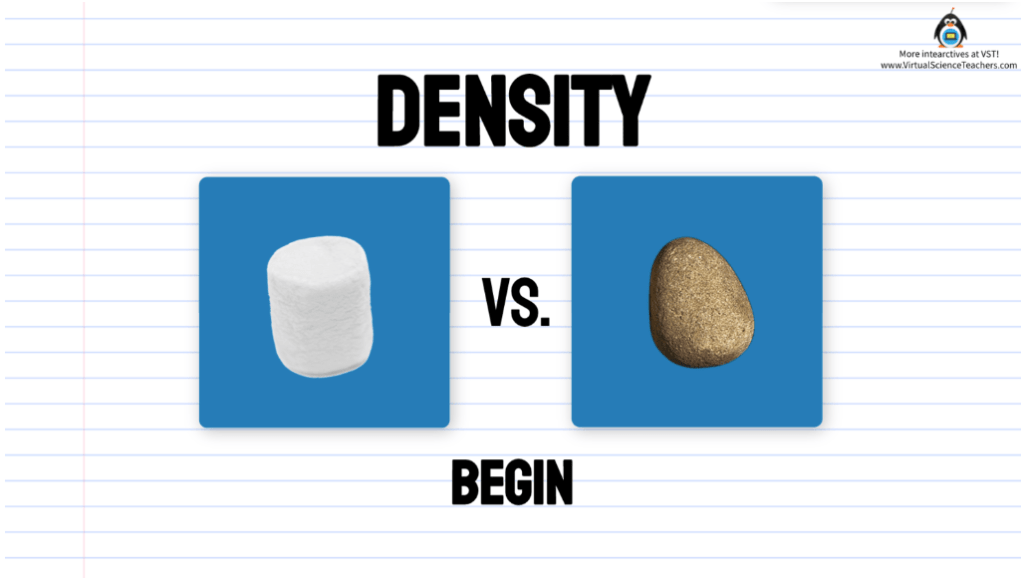
This is a very short and simple interactive that introduces mass, volume, and density.
- NGSS MS-PS1-2
- Virginia SOL PS.3a
Why does ice float?
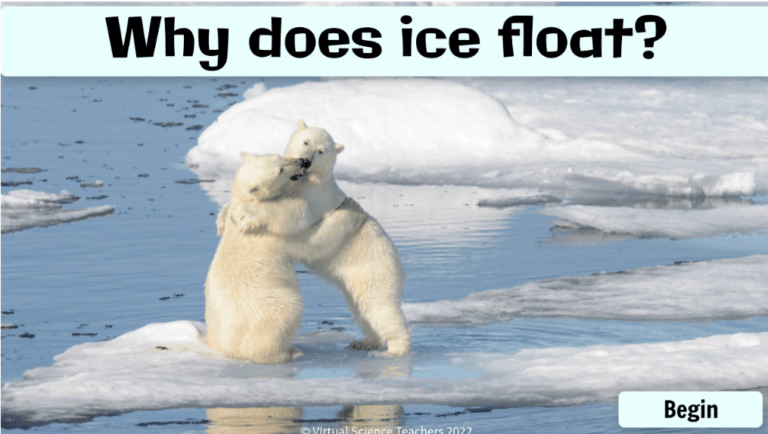
Concepts:
Use PhET’s States of Matter Simulation, analyze graphs, and learn about density to explore why giant icebergs float.
Standards:
- NGSS MS-PS1-2
- Virginia SOL PS.3a
- Screenshot Signature Page: Users can sign and screenshot the final page for proof of completion.
- Teacher Click-Through: A version without the screenshot page for quick module review.
- Worksheet with CER


Concepts:
Measure the mass and volume of six different candies using water displacement and the formula Volume=Length×Width×Height. Use these measurements, along with the included calculator, to determine and compare the densities of each candy.
Standards:
- NGSS MS-PS1-2
- Virginia SOL PS.3a
- Includes a calculator
- Screenshot Signature Page: Users can sign and screenshot the final page for proof of completion.
Density Escape Room
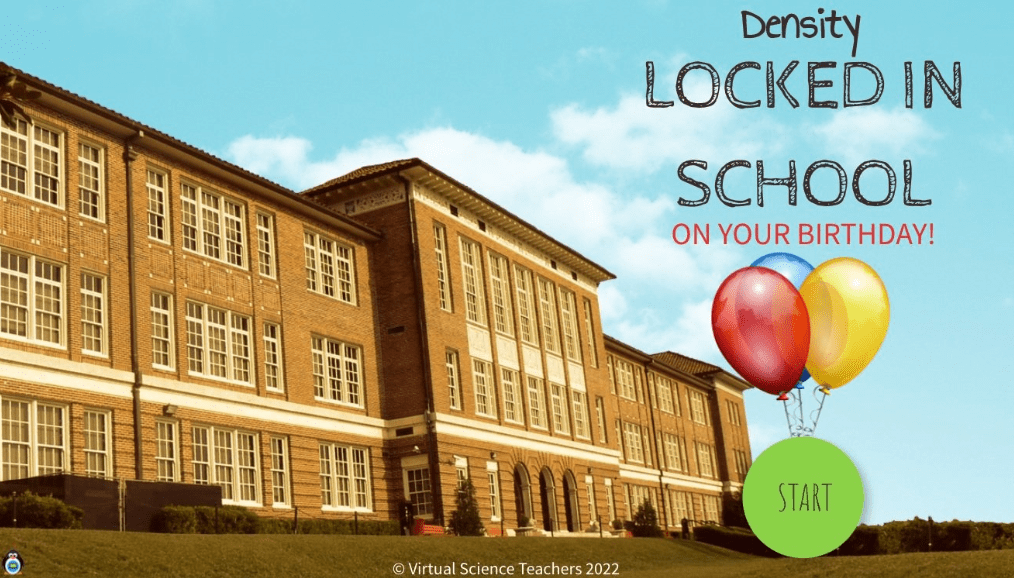
Concepts:
It’s your birthday and you’re locked in school! Get the code needed to turn off the security system and get to your birthday party on time.
- Definitions and units of mass, volume, and density
- Measuring mass and volume (water displacement)
- What sinks and floats in water
- Density calculations
Standards:
- NGSS MS-PS1-2
- Virginia SOL PS.3a
- Screenshot Signature Page: Users can sign and screenshot the final page for proof of completion.
- Teacher Click-Through: A version without the screenshot page for quick module review.
- Density Crossword

- Locked in School Worksheet

Heat Lamp Simulation
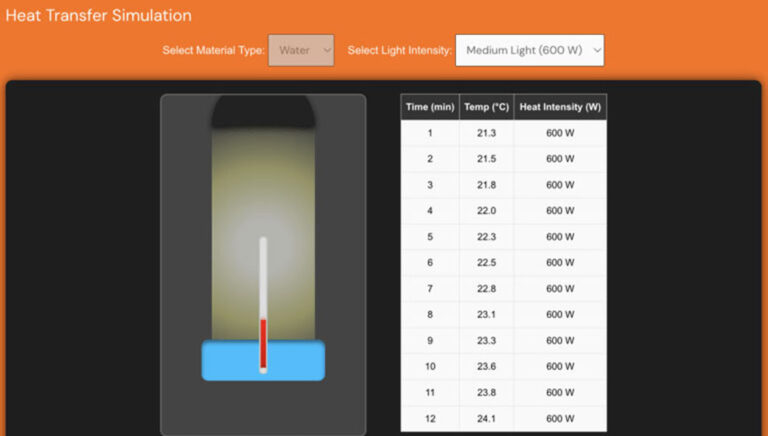
Concepts:
This simulation allows students to explore how different materials absorb and retain heat, emphasizing the relationship between heat energy and specific heat capacity.
- Line Graph Maker- Use the line graph maker to graph the changes in temperature over time.
- Bar Graph Maker- Use the bar graph maker to compare the temperatures of different materials or heat settings.
- Multiple Sets Line Graph Maker– This graph maker can be used to compare how different materials change over time or how a material changes over time depending on the heat settings.
- Simulation data collection worksheets and CER activities are coming soon!
Physical and Chemical Changes

In this interactive, you’ll learn the difference between physical and chemical changes by exploring clear explanations and real-world examples.
- NGSS PS1-2
- Virginia SOL PS.3b
- TEKS 6.6 E, 7.6 C
- Screenshot Signature Page: Users can screenshot their name on the final page for proof of completion.
The Combustion of Coal
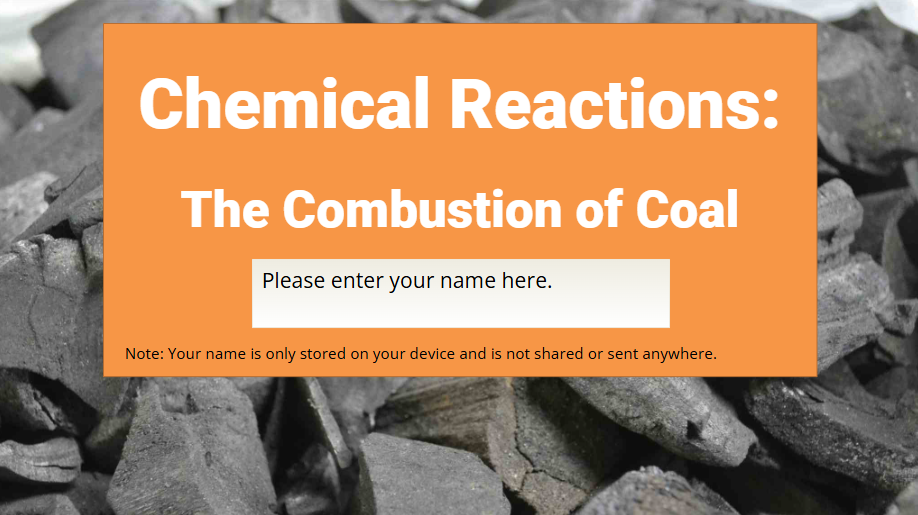
This interactive helps students visualize the chemical reaction between carbon and oxygen during coal combustion. They identify the reactants and product, and see how the reaction releases heat and light energy.
- NGSS PS1-1,5,6
- Virginia SOL PS.3, CH.3
- TEKS 6.6 E, 7.6 C, 8.6 E
- Screenshot Signature Page: Users can screenshot their name on the final page for proof of completion.
Rust Busters: Chemical Changes

Featuring STEM careers in the shipbuilding industry, this interactive lesson is about how steel is made, the chemical change for the formation of rust, and rust prevention.
- NGSS PS1-1,2,3
- Virginia SOL PS.3, CH.3
- TEKS 6.6, 7.6, 8.6
- Screenshot Signature Page: Users can sign and screenshot the final page for proof of completion.
Count the Atoms Practice

Concepts:
Students practice counting atoms in chemical formulas across varying difficulty levels, reinforcing their understanding of molecular composition and atomic symbols, with a fun challenge scoring system to track their progress.
Standards:
- NGSS: PS1-5, HS-PS1-7
- VA SOL , 6.5e, PS.3D, CH.3a
- TEK 7.6, 8.6
- Scored challenge for practice
Chemical Formulas Part 1

Concepts:
Students check their understanding by identifying elements and determining the number of atoms in a chemical formula.
Standards:
- NGSS: PS1-5, HS-PS1-7
- VA SOL , 6.5e, PS.3D, CH.3a
- TEK 7.6.B, 8.6.B
- Read-Aloud Feature: Users can click buttons to hear the text read aloud.
- Signature Page: Users can sign and screenshot the final page for proof of completion.
Chemical Formulas Part 2

Concepts:
Students check their understanding by identifying elements and determining the number of atoms in a chemical formula.
Standards:
- NGSS: PS1-5, HS-PS1-7
- VA SOL , 6.5e, PS.3D, CH.3a
- TEK 7.6.B, 8.6.B
- Read-Aloud Feature: Users can click buttons to hear the text read aloud.
- Signature Page: Users can sign and screenshot the final page for proof of completion.
Balancing Chemical Equations

Practice balancing chemical equations by entering coefficients, progressing through increasing difficulty levels while tracking accuracy and first attempts.
- NGSS HS-PS1-7
- Virginia SOL PS.3d CH.3c
- TEKS IPS 8.b, CHEM.9.A
- Scored Challenge
Stoichiometry Made Simple
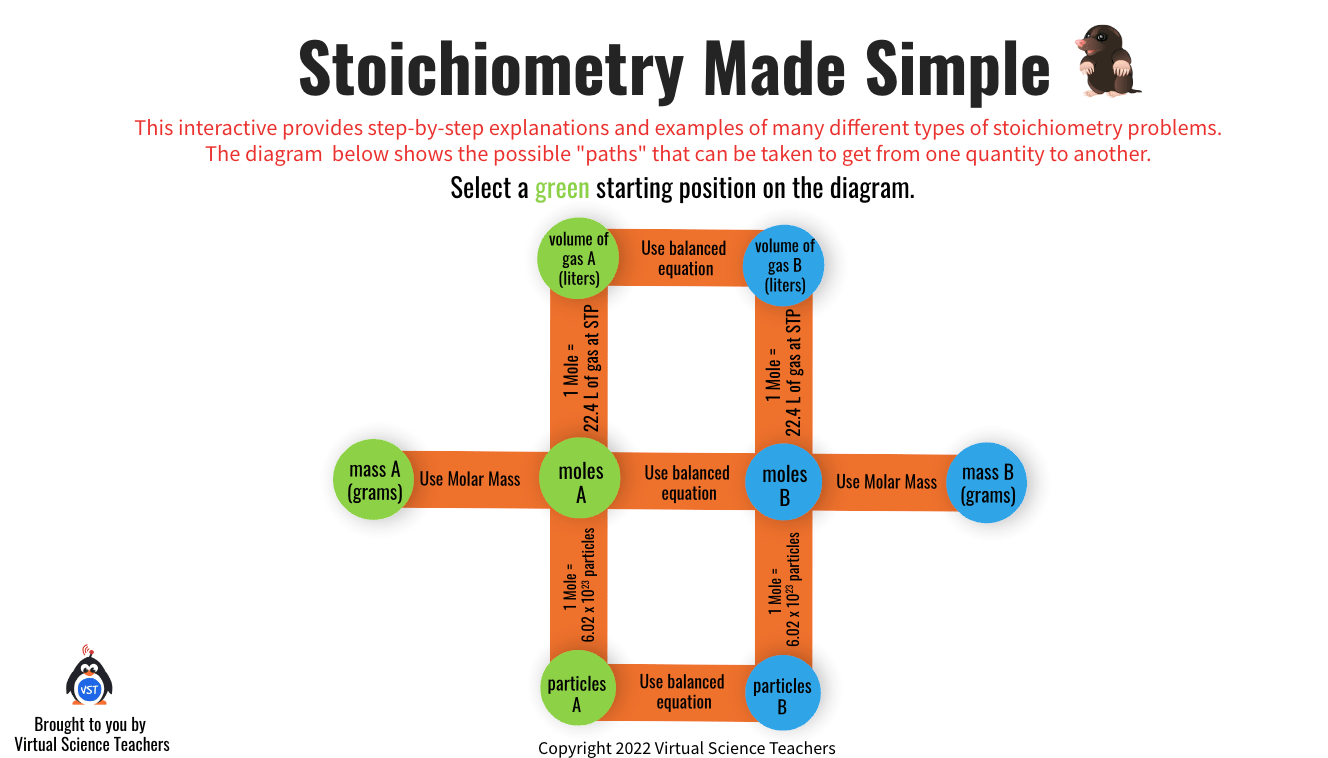
Step-by-step explanations of a the many different types of stoichiometry problems.
- NGSS HS-PS1-7
- Virginia SOL CH.4
- TEKS CHEM.8
Physics Concepts
Energy and its Many Forms
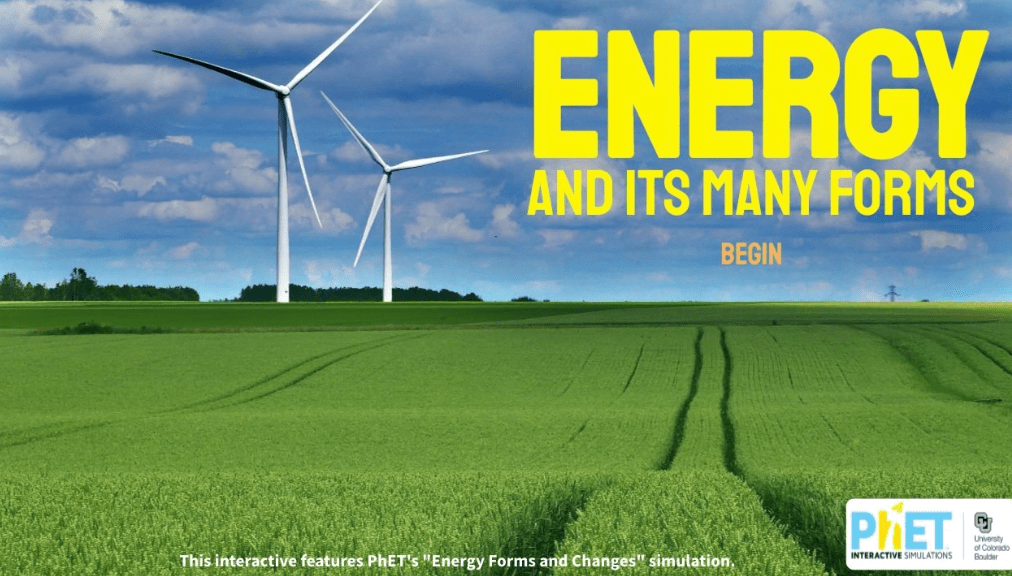
Concepts:
- Explore light, chemical, electrical, mechanical, and thermal energy. Use PhET’s sims to explore how energy changes forms.
Standards:
- NGSS MS-PS3
- Virginia SOL PS.5
- TEKS S.6.8
- Screenshot Signature Page: Users can sign and screenshot the final page for proof of completion.
- Engineer Design Challenge- On the last page of the interactive module, students use the images, arrows, and writing tool draw and label a system that uses at least 3 forms of energy.

- Teacher Click-Through: A version without the screenshot page for quick module review.
Potential and Kinetic Energy
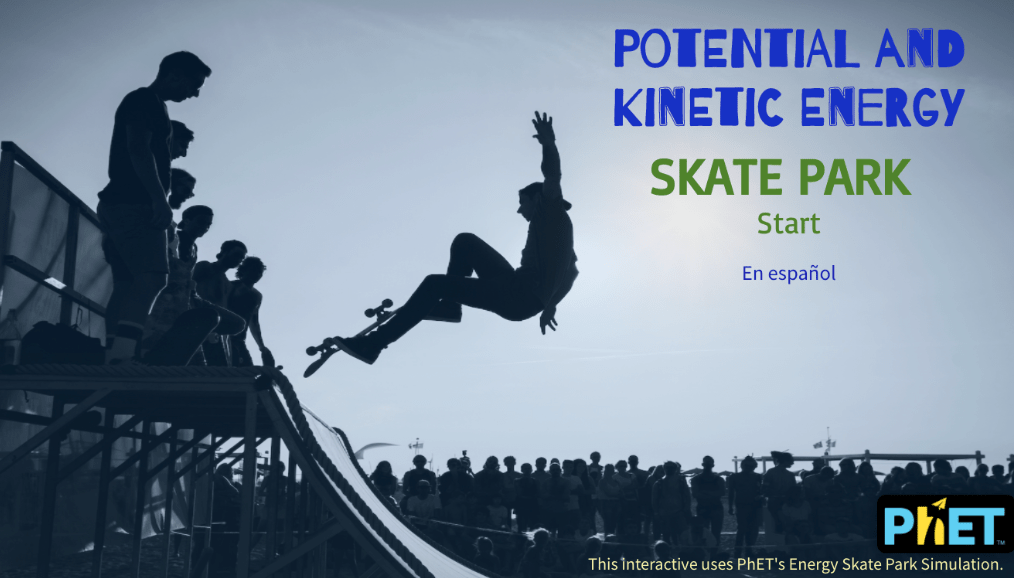
Concepts:
- Use PhET’s Skate Park simulation to explore potential and kinetic energy.
- NGSS MS-PS3
- Virginia SOL PS.5
- TEKS S.6.8
- Signature Page: Users can sign and screenshot the final page for proof of completion.
- Teacher Click-Through: A version without the screenshot page for quick module review.
- Worksheet

Distance-Time Graph Review

- Concepts:
Review the basics of distance vs. time graphs, including constant speed, acceleration, deceleration, and stop-and-go graphs.
Standards
- NGSS MS PS2-2
- Virginia SOL PS.8a
- TEKS S.7.7.C
- Read-Aloud Feature: Users can click buttons to hear the text read aloud.
- Screenshot Signature Page: Users can screenshot their name on the final page for proof of completion.
Distance vs. Time Challenge

Concepts:
- Match the red line on the graph by adjusting the skateboarder’s speed using the slider.
Standards
- NGSS MS PS2-2
- Virginia SOL PS.8a
- TEKS S.7.7.C
- Challenge: There are 10 levels to complete, each with increasing challenges. Unlock higher levels by scoring 8 or higher.
- Worksheets for this resource are coming soon!
Car Motion Simulation

Concepts:
- This interactive simulation lets users explore how velocity affects motion by comparing distance and displacement over time. As the car moves, it generates real-time graphs showing either total distance traveled or overall displacement, helping students understand the difference between these two concepts.
Standards
- NGSS MS PS2-2
- Virginia SOL PS.8a
- TEKS S.7.7.C
- Worksheets for this resource are coming soon!
Position vs. Time Graphs
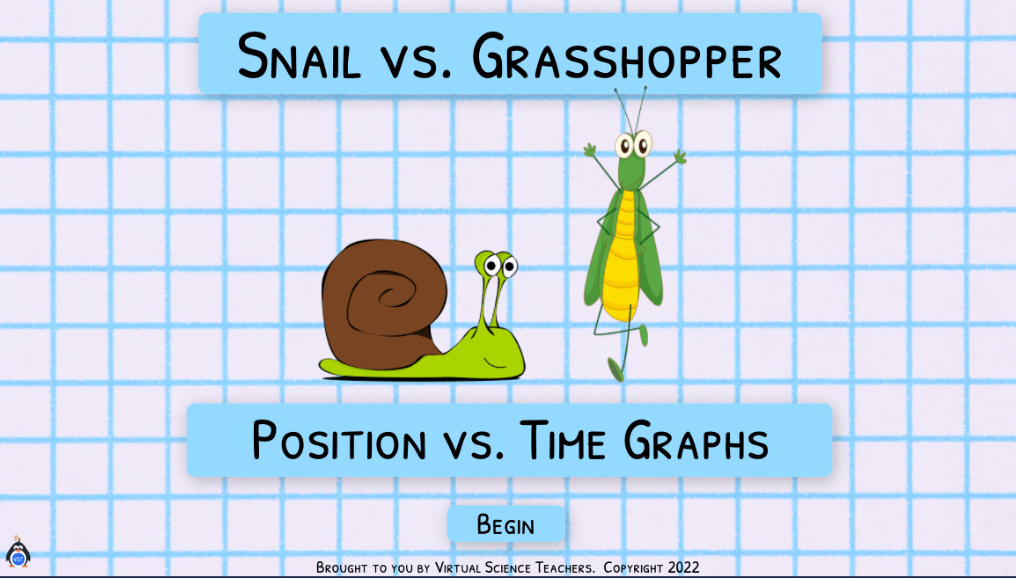
Concepts:
- Measure, record, and graph the distances Grasshopper and Snail travel each minute as they complete a 10 meter race. Use the graph to answer questions about the race.
Standards:
- NGSS MS-PS2-2
- Virginia SOL PS.8.a
- TEKS S.7.7b&c
- Screenshot Signature Page: Users can screenshot their name on the final page for proof of completion.
Balanced and Unbalanced Forces
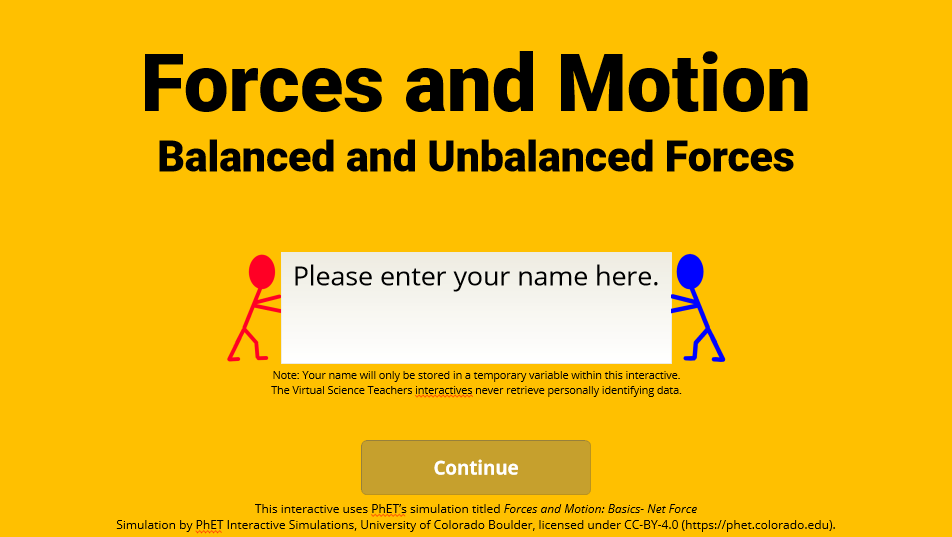
Concepts
- Review key forces vocabulary and explore PhET’s simulation to complete three sets of five questions. If a question set is answered incorrectly, you’ll have the opportunity to try again until you succeed.
Standards
- NGSS PS2-2
- Virginia SOL PS.8
- TEKS S.7.7.D
- Screenshot Signature Page: Users can screenshot their name on the final page for proof of completion.
Forces and Motion Challenge
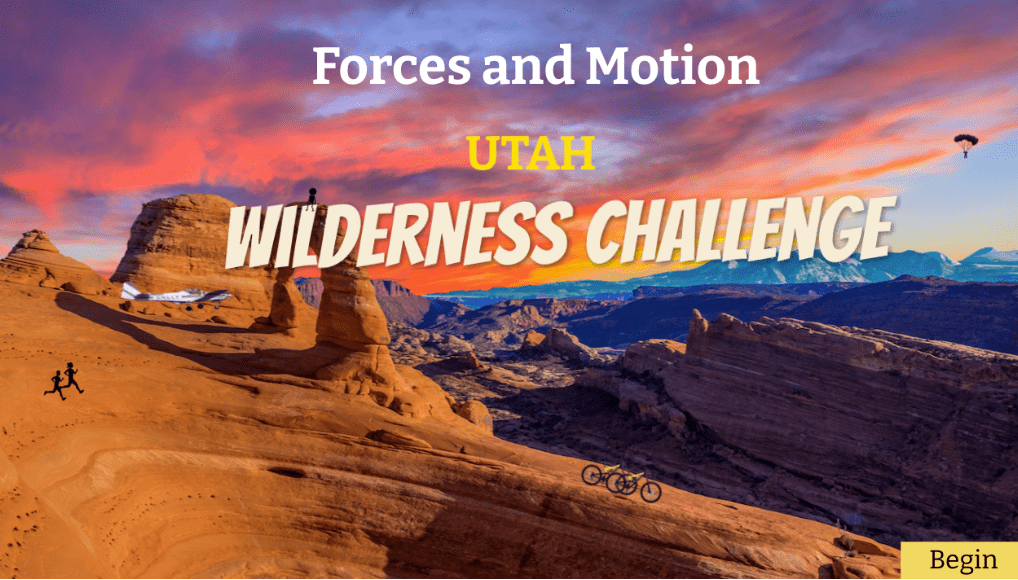
Go on an epic adventure through Arches National Park as you answer questions about forces and motion.
- NGSS MS-PS2
- Virginia SOL PS.8
- TEKS 6.7,7.7
- Screenshot Signature Page: Users can sign and screenshot the final page for proof of completion.
Bridges

- This basic introduction to bridges emphasizes compression and tension forces and highlights four common bridge types.
- Extension activity for Forces
- Read-Aloud Feature: Users can click buttons to hear the text read aloud.
- Screenshot Signature Page: Users can sign and screenshot the final page for proof of completion.
Bounce Height Simulation

- Explore how drop height, ball elasticity, and mass affect bounce height. Collect data to analyze and graph relationships.
- Adjustable parameters: drop height, ball elasticity, and ball mass.
- Real-time simulation of ball bounce behavior.
- Physics-based modeling for accurate results.
- Provides data for analysis and graphing.
- Bar Graph Maker: Effortlessly create bar graphs to analyze bounce heights.
- Visualize bounce heights for bounces 1 through 5.
- Compare the first bounce heights after adjusting drop height, elasticity, or ball mass.
Magnetism

- Concepts: Embark on a treasure hunt using a compass and map. Along the way, learn how compasses operate and explore the principles of magnetism and magnetic fields.
- NGSS MS-PS2-5
- Virginia SOL PS.9
- TEKS S.6.7
- Read-Aloud Feature: Users can click buttons to hear the text read aloud.
- Screenshot Signature Page: Users can screenshot their name on the final page for proof of completion.
New! Beta Testing
The Great Light Escape Room

Concepts:
- The Great Light Escape Room is an interactive, nonlinear digital escape activity where students explore the science of light through puzzles, videos, and code challenges. As they “escape” the virtual room, students investigate reflection, refraction, the visible light spectrum, transparency, translucence, and opacity.
Standards:
- NGSS MS-PS4-1& 2
- Virginia SOL PS.6
- Screenshot Signature Page: Users can sign and screenshot the final page for proof of completion.
Mechanical Waves
Escape Room

Concepts:
- Use PhET’s Wave on a String Simulation to investigate how increasing the frequency of a wave affects its wavelength.
Standards:
- NGSS MS-PS4-1
- Virginia SOL PS.6a
- TEKS S.8.8.A
- PhET’s Waves Simulations
- Screenshot Signature Page: Users can sign and screenshot the final page for proof of completion.
Electromagnetic Waves
Escape Room
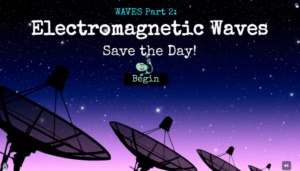
Concepts:
- Ditto needs help communicating with his ship so he can get back to his friends. Use PhET’s Waves simulations and your understanding of electromagnetic waves to help Ditto get home!
- Wavelength, Frequency, Amplitude
- Electromagnetic waves
- Visible light
- Uses of EM waves
- Communication using radio waves and binary code
Standards:
- NGSS MS-PS4
- Virginia SOL PS.6 & 7
- TEKS S.6.8.C & S.8.8A&B
- PhET’s Waves Simulations
- Screenshot Signature Page: Users can sign and screenshot the final page for proof of completion.
- Teacher Click-Through: A version without the screenshot page for quick module review.
- Worksheet

Waves Communication
Escape Room
Concepts:
- The cellphones in your town have all been stolen! Using radio waves and binary code, the thief sends you the information needed to find everyone’s cellphones and be the town hero.
Standards:
- NGSS MS-PS4-3
- Virginia SOL PS.7b
- TEKS S.8.8.B
- Screenshot Signature Page: Users can sign and screenshot the final page for proof of completion.
- Teacher Click-Through: A version without the screenshot page for quick module review.
CER: Frequency & Wavelength
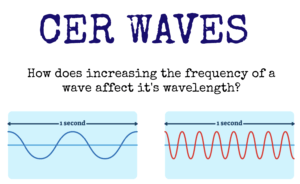
Concepts:
- Use PhET’s Wave on a String Simulation to investigate how increasing the frequency of a wave affects its wavelength.
Standards:
- NGSS MS-PS4
- Virginia SOL PS.6
- TEKS 8.8.A
- Uses PhET’s Wave on a String
- Print or Download PDF Report includes Data Table and Claim Evidence Reasoning Response
Waves Review

This short review defines waves, longitudinal waves, and transverse wave. Students answer 10 quick questions to check their understanding.
Concepts:
- Define waves
- Longitudinal and Transverse Waves
Standards:
- NGSS: MS PS4
- VA SOL: PS6.A&B
- TEKS: 6.8.C
- Read-Aloud Feature: Users can select a button to have the text read aloud.
- Screenshot Signature Page: Users can sign and screenshot the final page for proof of completion.
Converting Distance Units
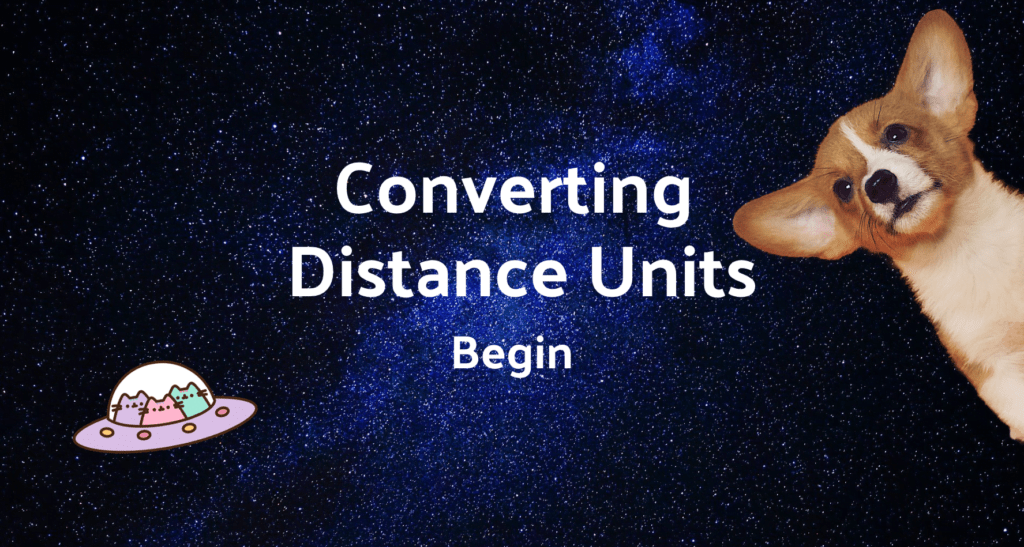
Concept
- This interactive activity begins with a silly scenario: determining if a puppy is tall enough to enter a park. It quickly transitions into a clear, step-by-step guide for converting a wide variety of units. While it starts with a lighthearted premise, the module focuses on teaching the math in an approachable way, giving students plenty of opportunities to practice this essential skill.
- Built in Calculator
- Screenshot Signature Page: Users can sign and screenshot the final page for proof of completion.
- Teacher Click-Through: A version without the screenshot page for quick module review.
- TPT Worksheet
This STEM programming is supported by the Virginia General Assembly through COVA STEM Hub.




